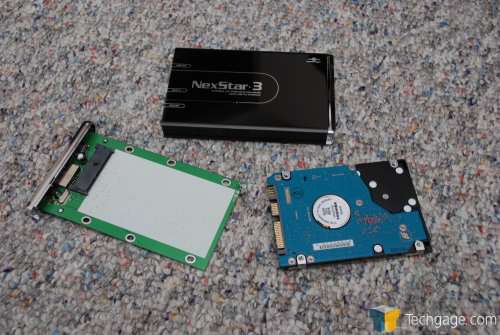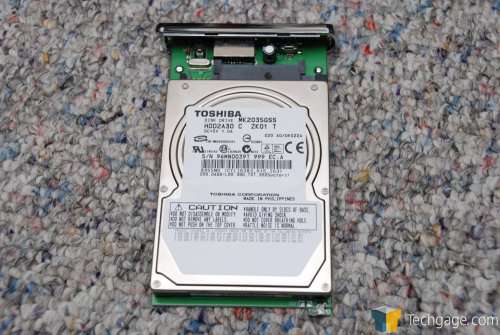- Qualcomm Launches Snapdragon 4 Gen 2 Mobile Platform
- AMD Launches Ryzen PRO 7000 Series Mobile & Desktop Platform
- Intel Launches Sleek Single-Slot Arc Pro A60 Workstation Graphics Card
- NVIDIA Announces Latest Ada Lovelace Additions: GeForce RTX 4060 Ti & RTX 4060
- Maxon Redshift With AMD Radeon GPU Rendering Support Now Available
Vantec eSATA Products Roundup
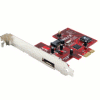
Are you looking to add eSATA or S-ATA storage to your PC, but your motherboards lacking a few connections? We are taking a look at a slew of Vantec products that take care of all your S-ATA needs.
Page 2 – Installation, Performance
The NexStar 3 proves to be the most difficult of the installations, but it’s hardly “difficult”. You need to remove the tray from the enclosure and then slide a 2.5″ S-ATA drive into place. No screws are necessary to secure it. Re-insert the tray into the enclosure and secure the entire unit with two long screws.
Here’s where installation gets fun. Do you want to install via eSATA method, or simply use a USB connector? For the USB connector, you just need to plug one end into the enclosure and the other into a USB port. It’s as easy as using a thumb drive, really. Except here, I have 200GB in my pocket as opposed to 4GB.
For the eSATA method, you first need to install a connector inside of your PC, which plugs into an available S-ATA port. Once done, you can connect the drive to the card via a cable that converts the S-ATA to eSATA.
Regardless of which product you are using, the installation is a real breeze. The most in-depth of the bunch is the enclosure, but it’s a snap.
To test out the PCI and PCI-E card, I will be using a Western Digital 500GB RE2 drive, and for the enclosure I will be using a Toshiba 2.5″ 200GB drive.
Before testing begins with anything we benchmark, the computer is cleaned up and optimized to run without a hitch. The hard drives were both fully formatted prior to testing. The programs we are using today are HD Tune, HD Tach, Sandra along with a few real world transfers.
Where “No Card” is specified, that simply means the hard drive was installed as normal, without the use of Vantecs products. The goal here is to see if using the products will lesson the overall speed, or use more CPU cycles. Also, the NexStar can be connected via eSATA or USB, so I have tested both to show a difference.
It’s really hard to point out a difference here, as there really is not much of one. The PCI-E cards average read was 0.3MB/s slower than the PCI card and direct installation. The Burst speed was significantly lower also, which is odd since this card is meant to be far faster than the PCI version. CPU Usage overall was the same for all the methods with the 500GB drive.
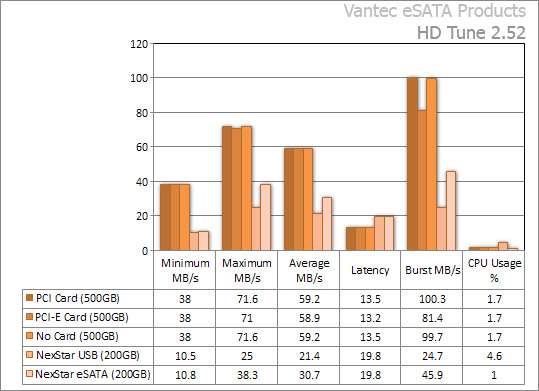
When taking a look at the NexStar though, it’s easy to see why eSATA is the preferred method. It means faster max speed, faster average and even lower CPU usage.
HD Tach shows similar results… there is virtually no difference between using the cards or plugging it straight into the PC. The Nexstar’s eSATA mode proved 4MB/s quicker on average over the USB mode. Bare in mind that this is only a 4200RPM drive, so if you have a 5400RPM drive you should expect greater speeds than is evidenced here.
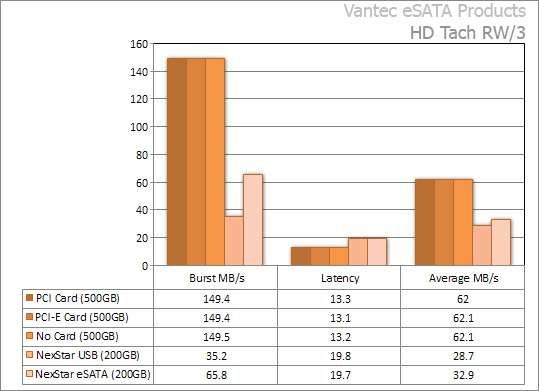
Oddly enough, the PCI-E card seems to be worse off than the PCI in each test so far. With SANDRA, the average MB/s is lower, and latency higher. Again with the NexStar, it’s clear just how bad USB can hold back performance.

|
|
Support our efforts! With ad revenue at an all-time low for written websites, we're relying more than ever on reader support to help us continue putting so much effort into this type of content. You can support us by becoming a Patron, or by using our Amazon shopping affiliate links listed through our articles. Thanks for your support!




